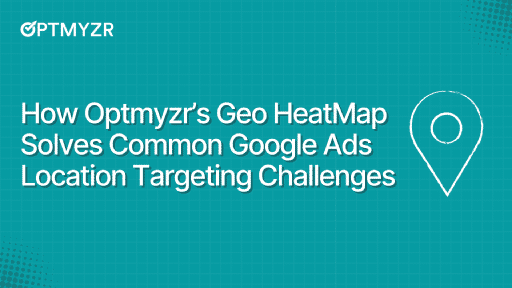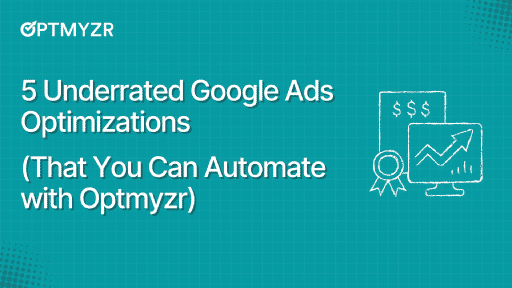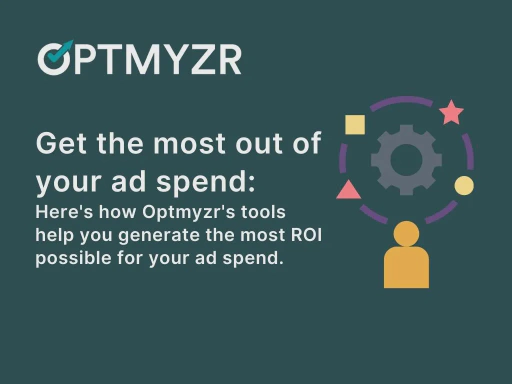Most PPC problems don’t start with a disaster. They start with a slow bleed.
A report that takes three hours instead of one. A budget that stalls for no clear reason. A CPC that spikes without warning. An “urgent” client email that lands at 9:01 AM, and again at 9:05.
None of these issues are catastrophic. But stacked together, they grind teams down and make performance flatline. And if you’ve spent any time on r/PPC, you know this isn’t rare, it’s the norm.
We picked out five of the most common challenges PPC managers vent about and looked at how to actually solve them.
In this article, we’ll break down each pain point and show practical, time-saving ways Optmyzr can help turn those frustrations into wins.
Challenge 1: Client reporting is dreadful
Ask any PPC manager what consumes their time, and reporting is likely to be on the list.
It’s not just pulling numbers but wrestling with endless spreadsheets, formatting charts for picky clients, and answering the dreaded “so… how are we doing compared to last month?”
The problem? Advertisers spend hours packaging data when they’d rather be optimizing accounts. Worse, generic reports often overwhelm clients with raw numbers but fail to tell a story.
That’s why reporting often becomes a constant pain point.
How Optmyzr fixes it
Start with templates, not a blank page.
Pre-built templates like the Executive Summary Report pull in account-wide performance and instantly highlight wins and losses.
You can customize them so clients see what actually matters: conversions, ROAS, or top performers, without drowning in irrelevant metrics.
Reports that answer back.
Instead of static dashboards, Optmyzr gives you reports with a built-in AI sidekick.
You can click on pre-set questions like “Summarize the key points of this report” or “Identify 3 areas needing attention” and get instant answers.
It feels less like sifting through numbers and more like having a mini-analyst inside the report.
Add tools that explain the why.
Numbers alone don’t satisfy clients. If conversions drop, they’ll ask, “But why?” and that’s where the PPC investigator comes in.
It’s a widget you can drop right into your report.
Instead of you manually digging through campaigns, the tool maps how impressions, clicks, and conversions are connected, showing exactly what caused the change.
Turn data into stories with AI
Another widget, the PPC Narrator, auto-writes a summary of what happened in the account.
Think of it as a plain-English “executive note” that lives inside the report. You choose the sentiment (positive, neutral, critical), and it generates a narrative like:
“Conversions increased by 12% last month, driven by mobile traffic. CPCs remained stable, while impression share improved due to higher ad rank.”
Now, even if clients skim the report, they’ll still walk away with the big picture.
Automate delivery
Schedule reports to hit inboxes (or Slack/Teams) on the 1st or 5th of the month, so you’re not hesitating when a client asks for an update.
Also Read: 12 PPC Reporting Tools That Tell the Story Behind Your Campaigns
Challenge 2: No time to do ad optimizations
Running Google Ads simply means balancing a lot of moving parts. PPC managers are flooded with metrics, reports, and errors to check, so there’s rarely enough time to give every campaign the attention it deserves.
On top of that, Google Ads keeps throwing in asset optimization suggestions, random errors, and new features to monitor. It feels like almost every time you open the account, there are ten new fires to put out.
But the biggest challenge is there’s simply not enough time in the day.
Between reporting, client calls, and strategy, PPC managers struggle to give ads the optimization they really need. Important improvements get delayed, and campaigns run on autopilot longer than they should.
How Optmyzr helps
Think of Optmyzr Express as your daily to-do list for ad accounts.
Instead of digging through endless reports and dashboards, Optmyzr Express shows you optimization suggestions across Google Ads, Amazon Ads, Microsoft Ads, and even Yahoo Japan Ads, all in one place.
- Quick wins in minutes: It works like an inbox. You log in, see suggestions (like “pause low-performing ads” or “add high-converting search terms”), and take action with just one click.
- Fast actions: Each suggestion comes with an Apply button to make the change instantly, or a Snooze option if you want to revisit it later.
- Stay organized: You can filter suggestions by account or type, and archive the ones you don’t ever want to see again.
- Backed by data: Recommendations are based on performance data from the last 30–90 days, so they’re timely and relevant.
- Multi-account support: Whether you manage one account or dozens, everything shows up in one dashboard.
With Optmyzr Express, what normally takes hours of checking reports and accounts can be done within a few minutes. It saves time, reduces overwhelm, and ensures that important optimizations actually get implemented instead of being pushed aside.
👉 Check all the available optimizations in the tool here!
Challenge 3: Getting clicks but not conversions
Sometimes campaigns look healthy on the surface: clicks and impressions are steady, search terms look relevant, and the landing page is solid.
But conversions just don’t happen.
This is one of the most frustrating challenges for PPC managers. You try new campaigns, pause old ones, even reset your strategy, but leads still don’t come in.
And you’re left wondering: Was it the new keywords? A change in audience behavior? Competition? Or something in the account setup that’s blocking conversions?
How Optmyzr helps
Our PPC Investigator makes it easier to understand exactly why performance shifted. It shows not just what happened, but where and why it happened.
Cause Chart
The Cause Chart helps you trace how a change in one metric flows through the rest of your performance data.
In the example below, conversions increased by 46 during the selected period.
The chart shows that this growth was driven by a higher conversion rate (+42%) and an increase in clicks (+16%), which in turn came from a small lift in impressions (+0.86%) and a stronger CTR (+15%).
By mapping the relationships between impressions, clicks, CPC, CTR, and conversions, the Cause Chart makes it easy to see not just what changed, but how each metric contributed to the overall result.
Root Cause Analysis
Drill down to see whether the drop is tied to a specific campaign, ad group, keyword, placement, or device. In the example below, PPC Investigator shows conversions rising sharply from 9 to 84 in just 30 days.
The Optmyzr AI Summary explains the change clearly: growth came mainly from the keyword “X” (+42 conversions), users in the “Not a parent” audience segment (+29 conversions), and the male demographic (+29 conversions).
This makes it easy to see why conversions increased and which audience segments or keywords drove the improvement.
While PPC Investigator helps you uncover why conversions dropped or shifted, Conversion Grabber helps you recover lost leads and capture more.
The tool finds keywords that are already bringing conversions but aren’t showing often enough, and suggests a bid increase so they can capture more leads.
You can apply bid changes automatically (e.g., +10%) or set custom bids manually, depending on how aggressive you want to be.
Challenge 4: Google Ads won’t spend the full budget
You set the budget, but Google Ads doesn’t always spend it fully.
Campaigns crawl, pacing falls behind, and you end up explaining why the account isn’t using the money that was allocated.
The tough part is figuring out what’s actually causing the slowdown.
Sometimes there’s not enough search volume. Other times, the budget sits in campaigns that can’t scale, while stronger ones are left underfunded.
Either way, underspending means missed opportunities and accounts that feel stuck in first gear.
How Optmyzr helps
Our Spend Projection tool makes it easy to see whether you’re on track to hit your budget or if spend will fall short. It analyzes past performance, daily spend patterns, and seasonality to forecast how much of your budget will actually be spent by the end of the cycle.
Here’s how it helps with budget pacing:
- Clear Forecasts: Instead of guessing, you’ll know if your campaigns are likely to underspend, overspend, or hit the target.
- Daily Guidance: The tool shows how much you need to spend each day to reach your goal, helping you take corrective action early.
- AI Summaries: Get plain-language insights about trends, weekday patterns, or seasonal shifts so you don’t waste time digging through charts.
But spotting the pacing problem is only half the battle.
Sometimes campaigns don’t spend the full budget because funds are tied up in places where they simply can’t scale, while other high-performing campaigns remain underfunded.
That’s where our Optimize Budgets – Single Account tool comes in. It makes sure your ad money is spent in the best way.
You pick the campaigns and set your monthly budget. The tool then checks if you’re on track, underspending, or overspending, and shows you options to fix it.
For example, say the advertiser wants to spend $7,000 this month.
But based on current performance, Google Ads is only on track to spend about $5,987 (that’s just 85.5% of the target). The tool points this out clearly and even shows that you’d need to average $262 per day to hit the full budget, which is $78 more per day than what you’re currently spending.
The table below then gives you options. For example:
- If nothing changes, you’ll finish around $5,987 spend with 97 conversions.
- If you could push spend up to $7,157 (+20%), the model estimates you could reach about 102 conversions (a +5% lift).
- Going further to $7,287 (+22%) could push you to 103 conversions (+6%), though at a higher cost per conversion.
So in this view, Optmyzr is showing: “Here’s the gap between what you want to spend and what’s actually being spent. Here are scenarios for reallocating budget to help you capture more volume and get closer to the target.”
Challenge 5: Paying high CPC even with no competition
It can be confusing to see impression share at 90–100% and still notice CPCs holding steady around $1. Even in markets with limited competition (niche markets), advertisers often expect lower costs but don’t see them reflected in their reports.
The problem is that Google doesn’t only use competition to set CPCs.
Even if you’re the only bidder, other factors, like ad relevance, expected CTR, and landing page experience, decide how much you pay. Google also has minimum bid requirements for each auction, and those don’t vanish just because you’re the only one bidding.
If your ads or pages don’t hit Google’s thresholds, CPCs stay higher than you’d expect.
That gap between “no competition” and “still paying a dollar per click” creates doubt and frustration. Advertisers start wondering if Google is overcharging, and clients get concerned about costs eating into margins.
How Optmyzr helps
Optmyzr gives you visibility into why CPCs are high and the tools to bring them down.
The Quality Score Tracker breaks down each component: CTR, ad relevance, and landing page experience, to help you spot exactly what’s dragging down performance.
If CPCs are being pushed up because of low relevance or weak CTR, you’ll see it right away.
The PPC Investigator takes this a step further by showing whether a spike in CPC is tied to a drop in CTR, a change in keyword performance, or shifts in impressions.
Instead of guessing, you know what triggered the increase.
When it comes to improving ad quality, Optmyzr has Ad Text Optimization (RSAs). This tool helps you test variations, refine headlines, and improve CTR, so your Quality Score goes up and CPC naturally comes down.
You can also clean up wasted spend with query mining tools like Search Term N-Grams and the Negative Keyword Finder, which help remove irrelevant clicks that hurt efficiency and CTR.
Finally, the URL Checker ensures landing pages aren’t quietly working against you.
If a page is broken, slow, or showing “out of stock” messages, Optmyzr flags it before it damages your landing page experience score.
Overcome your PPC challenges with Optmyzr
Running Google Ads will always come with hurdles: reports, optimizations, CPC swings, or budgets that don’t pace the way they should.
The hard part is keeping on top of all of it without losing focus on growth.
Optmyzr is built to take those frustrations off your plate. From reporting to optimizations, from CPC analysis to budget pacing, it gives you the visibility and automation you need to fix issues before they spiral.
Book a free trial and see how Optmyzr can help you run PPC campaigns more smoothly.
FAQs
1. What are the biggest challenges in Google Ads?
Common challenges include time-consuming reporting, budgets that don’t pace correctly, rising CPCs even with low competition, and campaigns that generate clicks but not conversions. PPC managers often struggle to balance these while still focusing on strategy.
2. Why is my Google Ads budget not spending?
Budgets may underspend if there’s limited search volume, if Google directs spend to campaigns that can’t scale, or if targeting settings restrict reach. Tools like budget pacing reports can highlight where money is stuck and how to reallocate it.
3. Why are my CPCs high with little competition?
High CPCs aren’t always caused by competitors. Google also factors in Quality Score, expected CTR, ad relevance, and landing page experience. Even with 90–100% impression share, weak Quality Score signals can keep CPCs elevated.
4. Why am I getting clicks but no conversions in Google Ads?
Clicks without conversions may be caused by mismatched keywords, poor audience targeting, landing page issues, or shifts in user behavior. Analyzing search terms, conversion paths, and audience segments can uncover the root cause.
5. How can PPC managers save time on Google Ads reporting?
Instead of manually building reports, using automated reporting tools with templates and AI summaries can speed up client reporting, highlight key wins and losses, and answer “why” performance shifted.









